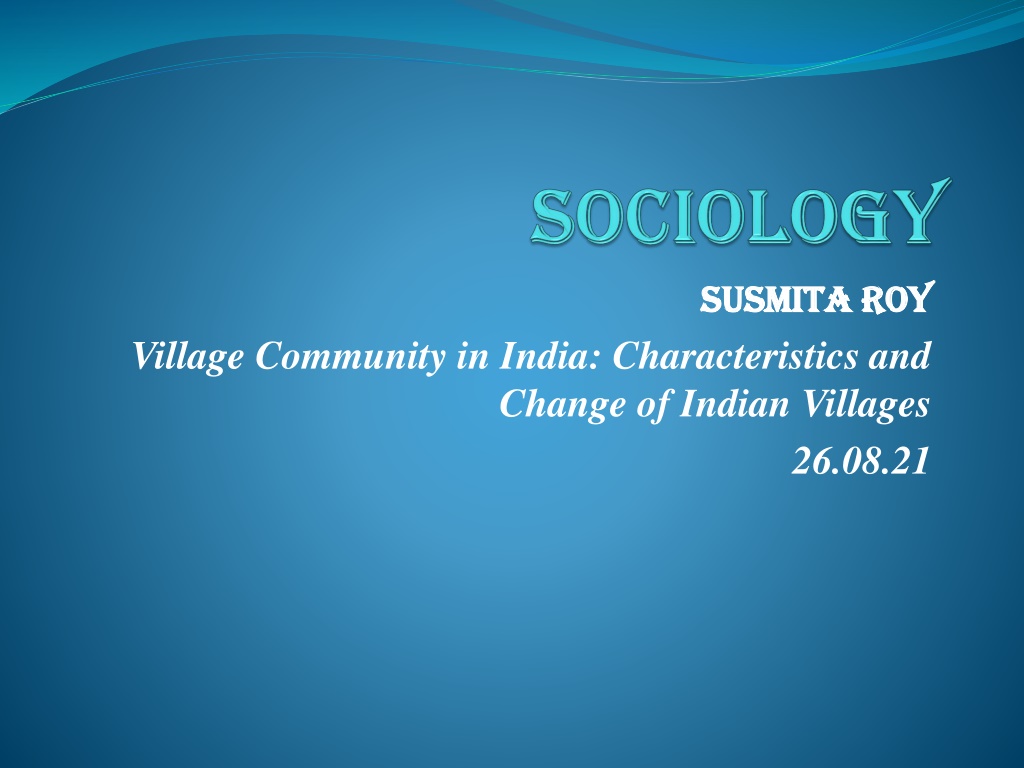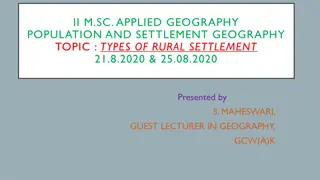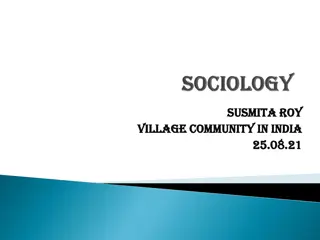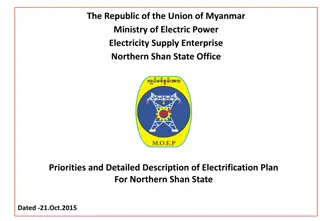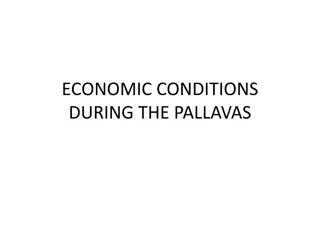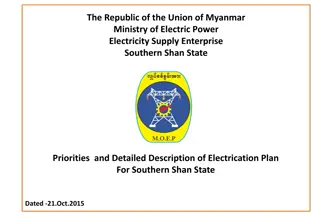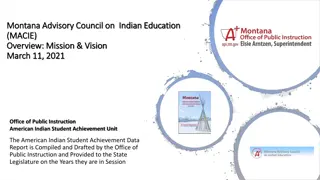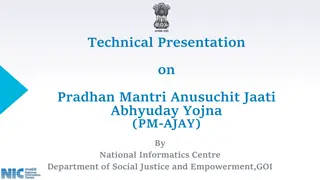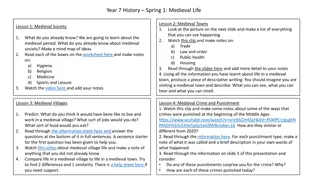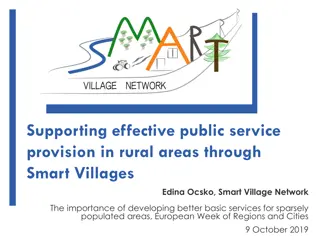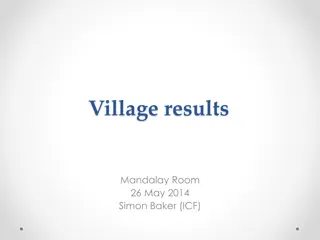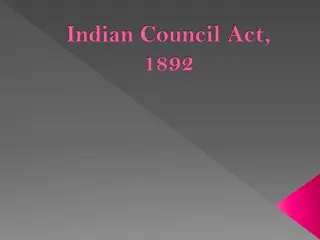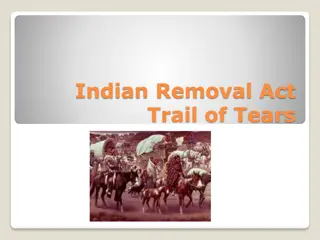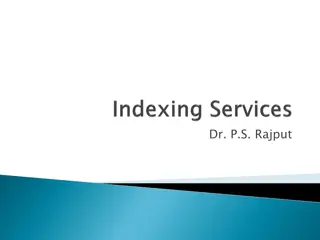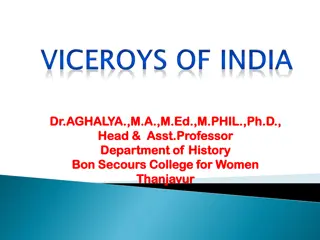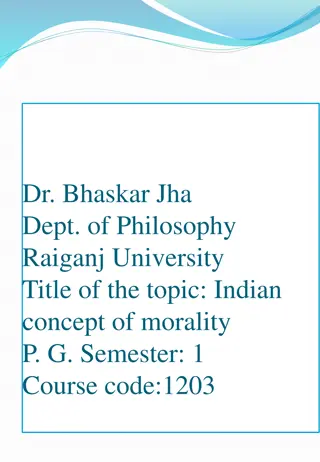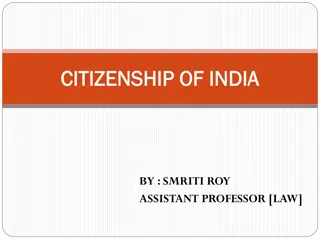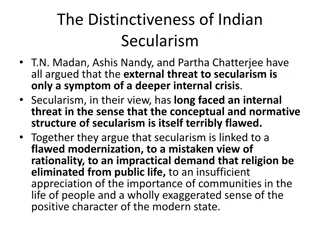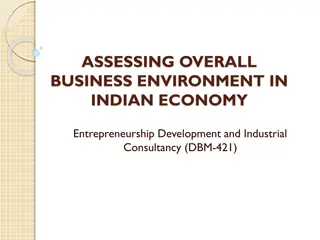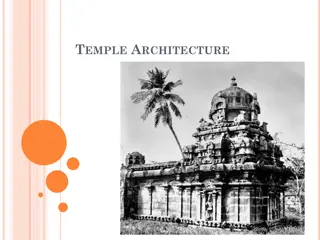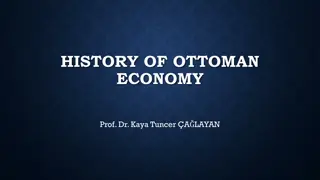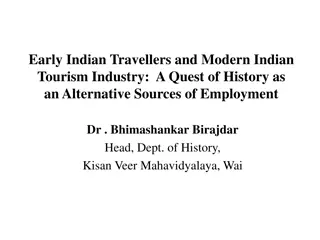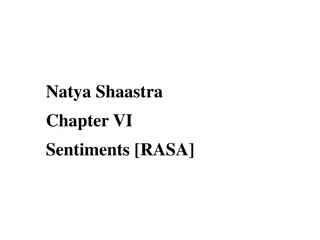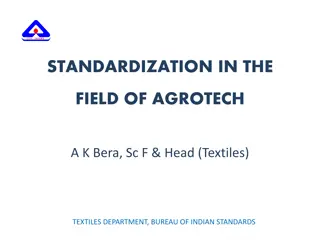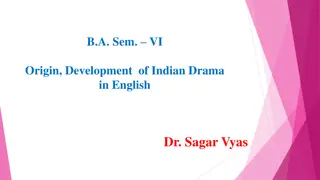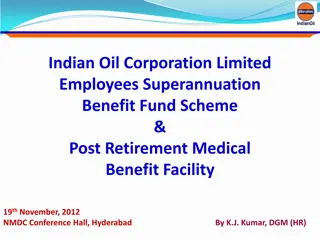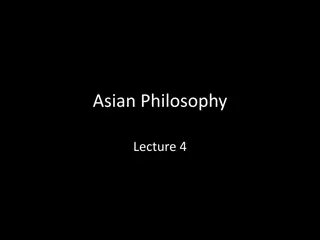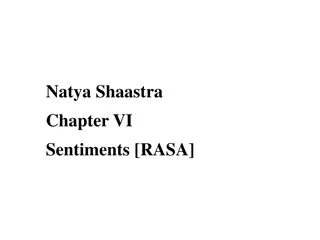Characteristics of Indian Villages and Their Changing Dynamics
Indian villages have historically been self-contained and isolated units, but changes in political and economic landscapes are breaking down these barriers. Villages are now socially and economically connected to towns and cities, although they still retain a sense of simplicity, peace, and conservatism. The inhabitants of Indian villages hold strong attachments to old customs and traditions, showcasing a reluctance to embrace change readily.
Download Presentation

Please find below an Image/Link to download the presentation.
The content on the website is provided AS IS for your information and personal use only. It may not be sold, licensed, or shared on other websites without obtaining consent from the author. Download presentation by click this link. If you encounter any issues during the download, it is possible that the publisher has removed the file from their server.
E N D
Presentation Transcript
SUSMITA ROY SUSMITA ROY Village Community in India: Characteristics and Change of Indian Villages 26.08.21
Village Community in India: Characteristics and Change of Indian Villages Villages play an important part in Indian life. From the prehistoric times, the village has been enjoying an important place as the unit of Indian social structure. India can righty be called a land of villages. The bulk of her population lives in the villages. According to the census of 1991, about 75 per cent of the total population lives in villages. There are 5, 75, 721 villages in the country, 26.5 per cent of the total rural population lives in small villages (under 500 persons). 48.8 per cent in medium sized villages (between 500 and 2,000 persons), 19.4 per cent in large villages (between 2,000 and 5,000 persons), and 5.3 per cent in large villages (over 5,000 persons).
Characteristics of Indian Villages: (i) Isolation and Self-Sufficiency: Almost till the middle of the 19th century, the villages in India were more or less self- contained, isolated and self-sufficient units. The inhabitants of the village had very little to do with the people outside. All of their essential needs were satisfied in the village itself. This feature of the Indian village is described graphically as follows: Each village tends to be self-contained, in each will be found persons with permanent rights in the lands as owners or tenants with hereditary occupancy rights; of these some cultivate all they hold, others with large areas at their disposal rent out to tenants on a yearly agreement a part or whole of their lands; below these in the scale are agricultural labourers . some have a field or two on rent, some work in the fields only at times of pressure and are mainly engaged in crafts, such as leather work, or in tasks regarded as menial.
However, changing political and economic conditions are putting an end to the isolation and self-sufficiency of the Indian village. The rapid development of the means of transport and communication has broken the barriers between the village and city. The former is now socially and even economically connected with the neighbourhood city or town. Political parties have made village the centre of their activities as much as die city. (ii) Peace and Simplicity: The second feature of an Indian village is the atmosphere of simplicity, calmness and peace prevailing therein. In the village there is no noise and little sophistication. The humdrum activities of modern civilisation are rarely seen there. Though occasionally a car or a bus rolling along the kutcha road enveloped in thick clouds of dust may be seen there, but, on the whole, life in the village moves with traditional quietude and peace. The villagers lead a simple life, eat frugally, dress simply, and live in mud-walled houses completely lacking in the trappings of modern civilisation.
(iii) Conservatism: The inhabitants of the village are strongly attached to old customs and traditions. Their outlook is primarily conservative and they accept changes with extreme reluctance. They love old ways and are less eager to follow the advice of zealous social reformers regarding their marriage and other customs. Writing on Indian villages, Sir Charles Metcalfe wrote, they seem to last where nothing else lasts. Dynasties tumble down; revolution succeeds revolution. Hindu, Pathan, Moghul, Marathe, Sikh, English all the masters change in turn, but the village communities remain the same. (iv) Poverty and Illiteracy: Probably the most glaring and also depressing features of Indian villages are the poverty and illiteracy of the village people. They are generally poor with a very low income. They take coarse food and put on rough clothes. The pressure on land is high resulting in fragmentation of holdings and poor productivity. Besides poverty the village people are steeped in ignorance and illiteracy.
The opportunities for education are meagre in the villages. The village school is generally in a dilapidated condition. Facilities for higher education are practically nil. Due to poverty the villagers cannot send their sons to city for education. Due to illiteracy they cannot improve upon their agriculture or supplement their income by other means. Poverty is thus the cause and effect of illiteracy and the backwardness of the villagers. However, recently the need has been realised for rural reconstruction. An all India organisation under the name of All India Kissan Sammelan has been formed to focus the attention of the government on the problems of peasantry class. There is greater realisation now that the country can march ahead only if its villages are prosperous. The governments, both at the centre and states, have launched numerous schemes like total literacy programme, fertilizer subsidy, crop insurance, free power, concessional water-rate, minimum procurement price and low- interest loans for liquidating illiteracy and removing poverty of the people living in the villages. Agricultural production is becoming more and more mechanized and agricultural products are fetching high prices.
(v) Local Self-government: The villages in ancient India enjoyed a considerable measure of autonomy or self- government. The villagers managed their own affairs through the traditional institution of Panchayat. The central government had neither the inclination nor the means for interfering with the self-government of villages. With the advent of Britishers in India and their introduction of a highly centralised system of administration the importance of Panchayats began to decline. Their judicial powers were taken over by the British courts and the officers were appointed to look after the administrative affairs of the villages. This change produced unpleasant results. Since the times of Lord Ripon attempts were made to revive the old system of village local self-government, but the progress was very slow in this direction. With the attainment of freedom now fresh efforts are being made to strengthen the panchayat system and make Panchayats play a better part in the work of national reconstruction. The 73rd Amendment Act, 1993 has laid the foundation of strong and vibrant Panchayati Raj institutions in the country.
Change in Village Community: Change is the law of nature. It is the need of life. Change is but natural in human communities. The village community is less susceptible to change than the urban community; but it does not imply that village community undergoes no change. It is also undergoing change though the speed of change as compared to urban community is slow. The change in village community may be seen in different spheres: (i) Caste System: The British rule in India gave a serious blow to the caste system in the villages. The economic policy and the laws of British rulers induced the different castes to adopt occupations other than the traditional ones. The hold of caste panchayat was loosened. The status of a village man was determined on the basis of his economic position and personal attainments. The restrictions on food, dress, mode of living and other matters imposed under caste system were removed. Even untouchability was weakened. Thus caste system has now lost its traditional hold in the villages, however, casteism is getting strengthened on account of selfish political interests.
(ii) Jajmani System: Social Stratification in India the Jajmani system, a feature of village community in India has now weakened due to the governmental efforts to raise the status of the lower castes and impact of urbanisation. The occupations adopted by the village people are not entirely hereditary or based on caste system, nor the payment for services rendered by the lower caste is in kind; it is now mostly cash payment. (iii) Family System: The joint family system is no longer the peculiar characteristic of the village community. Nuclear families have taken its place. The family control over its members in matters of diet, dress and marriage has weakened. The family is no longer an economic unit. Several activities which once were carried within the family are now performed by outside agencies. The education of village girls has raised the status of rural women.
(iv) Marriage System: Change can also be seen in the institution of marriage. Although inter-caste marriages are rare and parents continue to dominate the mate-choice, yet the boys and girls are consulted by the parents in the matter of mate- choice. Love marriages and divorces are almost non-existent. The individual qualities like education, economic pursuit, beauty and appearance of the marriage partners are given preference over the old family status. There is now less expenditure on marriages. The marriage rites also have been minimised. The custom of child marriage is being abolished. (v) Living Standards: The standard of living in the village community is gradually going higher. The rural diet no more consists of coarse food only. It now includes vegetables, milk, bread, tea and vegetable ghee. The dress is getting urbanized. The youths put on pants and the girls put on frocks and Bell Bottoms. Even the old ladies put on blouses instead of shirts. The mill cloth is used in place of handloom cloth. Gold ornaments have replaced the old heavy silver ornaments. The young boys live bare-headed with well combed long hair while the girls use cosmetics. There are now pucca houses to live. These are now better ventilated, well furnished, and in some cases electrified too. The ceiling fans can also be seen in some houses. Lanterns have replaced the earthen lamps in most houses. Gobar gas plants have also been installed in some houses. The sanitary habits of the people have improved.
They now use soap for bath and washing the clothes. The safety razors are used for shaving. The drainage system is also better one. The primary health centres have made the villages people health conscious. The threat of epidemics has lessened due to the vaccination and other preventive measures taken to the villages. The family planning program has been understood by the village people who now adopt measures to limit the family size. Schools have been opened. In some villages degree and post degree colleges can also be found. Agriculture Institutes and other Rural Institutes have also been opened in some villages. (vi) Economic System: Change has also taken place in the economic field. The educated rural youth seeks jobs in the cities rather than settle on the land. The demand for new scientific instruments of agriculture is increasing. The farmers have been taught new methods to raise their production. The rural cooperative societies have lessened the woes and miseries of the village people in getting seeds, fertilizers and credit. The Sahukara system is on the wane. More and more banks are being opened in the villages. The Government gives financial assistance and other facilities for setting up industries in the villages. The per capita income has increased. Economic exploitation has decreased and the farmers get good price for their products.
(vii) Political System: The setting up of panchayats has led to the growth of political consciousness among the village people. The newspapers, radio and television in some areas have added to the political knowledge of the villagers. However, the political parties have divided the people into groups and led to groupism among them. Caste conflicts and. group rivalries have increased. The community feeling has decreased. Selfishness and individualism are growing. It is thus evident that the Indian village is not a static community. It is dynamic. Sir Charles Metcalfe was wrong to hold that the village communities in India seem to last where nothing else lasts.
The villages in India are at present passing through a transitional period. From the sociological point of view the old social relations, bonds and ties have disappeared. The community consciousness is steadily decreasing. Politics of the country has made deep in roads into the peaceful life of the village people and has divided them into political and sub-caste groups. The joint family system is fast disintegrating and morality has gone down. The only feature of the village community now left is agriculture. In India the task of rural reconstruction is a big and complicated affair not to be accomplished easily. As we have seen above, 75 per cent of population lives in villages. To raise the standard of living of 64 crores of people is no easy task. However, the trends show that considerable progress is under way despite great difficulties.
A Ministry of Rural Development has been formed at the centre to look after the overall task of rural development and co-ordinate the different schemes in this direction. Agricultural development along with irrigation and generation of electric power had the highest priority in the First Plan. Both the short term and long term objectives of the First Plan were by and large achieved. In the Second Plan new targets of agricultural production were laid down which have been more than achieved. In the Third and Fourth Plans also adequate importance was given to the task of rural reconstruction. The successive plans also have given due attention to the programme of rural development. Various schemes like Small Farmers Development Project (SFDP), Marginal Farmers and Agricultural Labourers Project (MFAL), Drought Prone Areas Programme (DPAP), Integrated Rural Development Programme (IRDP), Applied Nutrition Programme (ANP) and finally Jawahar Rozgar Yojna Programme have been in vogue for the upliftment of rural masses. The rural school is undergoing transformations under the impact of Operation Blackboard. It is now better equipped and adequately staffed. The introduction of labour- saving machinery has shortened farm hours, decreased the difficulty of labour and increased the amount of leisure time. Link roads are being constructed in the villages, electricity provided, sanitary conditions improved, health facilities provided and well- equipped hospitals with qualified doctors opened.
Many of the conveniences and comforts of the city are being introduced into rural homes. The 73rd Amendment Act, 1993 has sought to make the Panchyati Raj System more effective and role playing in the field of rural development. With the passing of the unattractive, barren and drudgery features of village home, it is hoped, there would come a new appreciation of the deeper rural values so that the young men would not flee to the cities, depriving the village of energetic and educated rural leadership.
